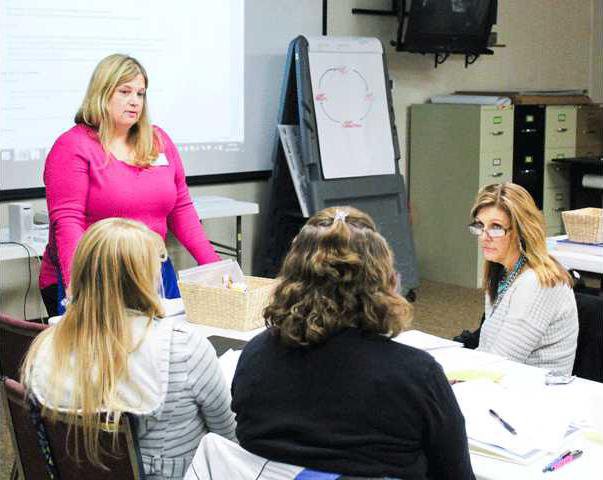Math. For many, the word can induce a cold sweat as recollections of struggling to understand lessons, humiliation from failing at board work and feeling too embarrassed to ask questions come to mind.
But in Great Bend schools, things are changing. Math instructors at Great Bend Middle School began using teaching techniques that will ratchet lesson retention from C level to A level. At the same time, using teams and cheers, they’re creating a classroom culture that better resembles a pep-club meeting than the tortuous routine of years past.
In August, district middle school math teachers attended a Power Teaching workshop by Success for All, where they learned some radical new techniques for teaching math to grades 7-12, regardless of curriculum. Feedback has been so overwhelmingly favorable, math instructors at Great Bend High School demanded the district provide Power Teaching training for them also.
“Great Bend Middle School has the best implementation of any school so far,” SFA Power Teaching instructor Michelle Hartz. “With the high school coming on board, Great Bend has the potential to be a flagship school district for Power Teaching.”
Wednesday and Thursday, GBHS math teachers attended the preliminary workshop at the District offices, where they learned how and why the techniques are successful. Power Teaching uses cooperative learning to actively engage students in lessons. But to achieve this, teachers have move some furniture around, get up out of their chairs and move, and lead students in cheers, clapping, and for the bold, even some dancing.
Each lesson will have time for active instruction from the teacher, teamwork, assessment and celebration.
High fives
Celebration is probably the most unique aspect of the classroom culture. During the training Wednesday, teachers were shown several videos of how Power Teaching teachers used cheers in the classroom to reward students when individuals and teams succeeded. In addition, teachers manage teamwork through encouraging hand gestures, clapping, and several other movements to help keep students awake and focused.
While some teachers expressed concern about how to put all the techniques together, and were skeptical that high school students would be receptive to some of the more active cheers, they were reassured by middle school math facilitator Kelsey Metro that students become very possessive of the routines once they are fully implemented.
“The most successful teachers are those who feel the most comfortable with implementing the cheers,” she said.
Seeing eye to eye
Instead of each student facing front, working each problem on their own, students will sit in teams, facing one another, and will work through problems first together (called a “team huddle”) then on their own, checking back to see if everyone in the team found the same answer.
The teams are important for building a cooperative learning environment.
“Research has shown that using cooperative learning in the classroom has positive effects in more than just academic achievement,” according to Success for All’s literature. “When students work together toward a common goal, academic work becomes valued by peers.”
The team model helps motivate students to help one another learn, take responsibility for their own learning, translate the teacher’s language into “kid talk” for one another, learn to see situations from another’s point of view, justify their own viewpoint and analyze ideas, and have fun learning.
In addition to individual assessment, teachers also grade teams on participation, and monitor to make sure each team member is taking part in both learning and teaching.
“One of the reasons the team approach is so important is because students retain 95 percent of what they teach someone else,” said Hartz. “Compare that to the 50 percent retained when a student is merely taught a lesson.”
Side effects
According to Success for All, in addition to academic achievement that Power Teaching produces, there are some interesting side effects that have little to do with the subject matter.
Teachers are encouraged to thoughtfully select teams, keeping an eye towards complementing student’s characteristics and abilities. The goal is to make each team of four or five as heterogeneous as possible.
“Teachers need to keep in mind each student’s abilities, ethnicity, gender, level of motivation, personality, language ability, and other factors when forming teams,” Hartz said. “Varying levels of past performance is needed so students can teach and learn from one another.”
The teams stay together for four to eight weeks at a time so they can build trust in one another. At the end of the period, teachers are encouraged to have a good-bye ceremony before moving students into new teams, which is also necessary so they can learn to work with more types of people.
All of this results in positive effects on interethnic relationships, development of English proficiency, acceptance of mainstreamed academically handicapped students, self-esteem, attitudes toward other students and attitudes toward school and teachers, which has played out in Power Teaching classrooms for the past 25 years, Hartz said.
John Popp, USD 428 curriculum director, is pleased with the program at the middle school and is excited to bring the same to the high school.
“We wanted to get it in place before next year because middle school students are already being immersed in it this year, so as they enter high school, it will give continuity to the program,” he said.
If the high school does as well as the middle school, parents may cease hearing the popular refrain, “I hate math”.
Weve Got The Power
USD 428 introduces Power Teaching model to 7-12 math





